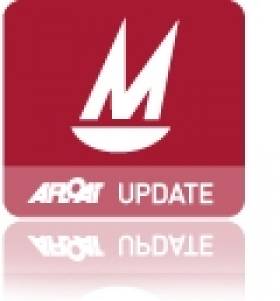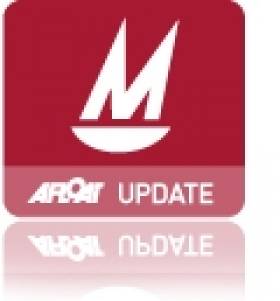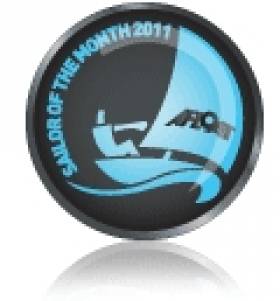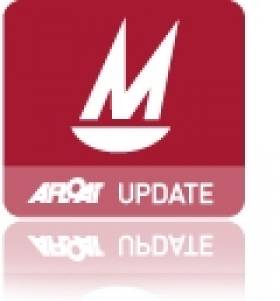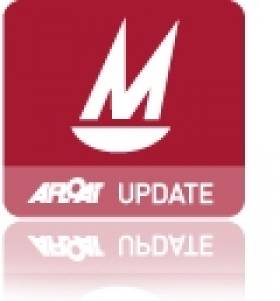Displaying items by tag: Mirror
#mirrors – The season for the Mirrors got off to a great start over the weekend in Lough Ree Yacht Club with the Western Championships writes Brid Hickey
Speaking to Graham Elmes, coach for the Mirror class on Saturday after 4 races, ‘There were testing conditions with shifts in the winds and varying wind speeds of 2 -8 knots, which will prepare the sailors for the Mirror Worlds being held in Lough Derg later this year’.
The first day’s racing saw a different sailor win each race namely Tiarnan Dickson with his crew Alex Leech Lough Ree YC winning the 3rd race and lying first overall at the end of day 1 with 5 points. Cian Hickey Skerries S C with Caolan Croasdell LRYC lying 2nd overall with 8 points and winning race four. Beth Armstrong Sligo YC and her crew Samuel Wray also had 8 points and she won the first race of the event. Peter Reegan and Eugenie Dalby from Lough Ree YC was lying fourth and he won the second race.
The wind shifts might have been the cause for the sailors’ failure to maintain consistency according to some of the onlookers from David Dickson’s barge. However, it should be pointed out that Tiarnan did have 1 first and 3 seconds – possibly local knowledge could have played a factor here.
Day 2 of the Westerns took place in blustery conditions which would have appeared to suit some of the more weathered sailors. With wind gusting up to 20 knots in a very cold north easterly wind three very exciting races took place.
The races kicked off with Race 5 which was won by Cian Hickey and Caolan Croasdell with Jacy Maye and Oisin McAllister coming in second and Ronan Armstrong and Eva Martin from Sligo YC coming 3rd. Best of the silver were local sailors Jack Ryan and Ben Gaf in race 5 and the best of the bronze was Sutton sailors Shane Mcloughlin and Ben Jennings. Race 6 was won by Cian & Caolain and followed Ronan Armstrong and Eva Martin coming in a close second followed by other Sligo sailors Beth Armstrong and Samuel Wray. Going into the last race there was just one point between the top two sailors Cian and Caolan on 10 points and Tiarnan and Alex on 10 points and Beth and Samuel on 17 points.
Cian and Caolan held onto their winning form and won the race. 2nd place in the final race went to Shane McLoughlin and Ben Jennings SDC and 3rd place went to Ronan and Eva from Sligo YC. Overall racing proved very exciting over the 2 days a key factor would be the excellent racing provided with thanks to the PRO Vincent Rafter and his skilled team.
Overall racing proved very exciting over the 2 days a key factor would be the excellent racing provided with thanks to the PRO Vincent Rafter and his skilled team.
Congratulations to Shane McLoughlin and Ben Jennings from Sutton DC who now move up to the Silver fleet and, and Jack Ryan and Ben Gaf LRYC who move up to the Gold fleet.
Local Crew Win Mirror Nationals at Sligo Yacht Club
#mirror – Overall honours at the Mirror dinghy national championships in Sligo went to local sailors Jack Maye and Sarah White at the weekend.
After two days of training kindy provided by Sligo Yacht Club the Mirror fleet, from Bronze to Gold, were well prepared for 4 days of extremely variable conditions and tight racing results. Thursday saw light winds which gave the lighter helm and crew a chance to perform well. Friday was a day of doldrums and scorching sunshine which led to a day of patient floating about and ended up with some essential swimming and diving to cool off. Despite the best efforts of vetran Race Officer Gus Henry however, no race could be started. On Saturday the winds picked up with force 7 gusts and numerous capsizing of all ages and skills levels came to the fore, so the OD announced that all Bronze fleet must go in after the first race. The course was then moved inshore where there was some shelter and the gold and silver fleets had two very exciting races. The overnight leaders were Harry & Fergus Collins of Sligo, a considerable achievment for them as they were Silver Fleet sailors.
It was all down to the Sunday, the last day. By then gold and Silver had finished five races but the Bronze fleet had only three.
The Race Officer decided to have three races, which had the effect, if all were finished, that the second discard would kick in. Depending on the various permutations and combinations, it was still anyones regatta with six or even more possible winners.
A good force 3 South Easterly occationally gusting force 5 for perfect sailing conditions. The 3 races were completed and results were close. The final places were not decided until the last race, which developed into a ding dong battle between Kerry-Ann Boylan of Skerries, Beth Armstrong of Sligo, Peter Regan of Lough Ree and Jack Maye of Sligo which finished in that order. Noone had any idea who was the overall winner until the computer did its work and a final protest was decided, but Jack and Sarah had done just enough to take the Championships by a point from the Collins brothers.
A number of the Gold fleet sailors are now preparing for a trip to the Mirror Europeans in Poole in 2 weeks time, while the Bronze fleet sailors prepare for the Mullingar Bronze fleet event later this month while the highlight for the class is the staging of the Mirror Worlds in Lough Derg 27 July to 2 August 2013.
Mirror Sailor's Shanty for Irish World Championships
#MIRROR–As sailing regattas around the world bid to outdo each other running sophisticated social media campaigns, it looks like the tiny Mirror dinghy has stolen a march on even the Volvo Ocean Race's Galway Girl with a specially composed song for its next World Championships.
The 2013 Mirror World Champs is bound for Ireland, the event previously having been held in Sligo in 1987. More recently, in 2010, Sligo Yacht Club also hosted the class European championships.
The unique red sails shanty is presented in a youtube format and comes all the way from Albany, Australia, the venue of the last world championships won by Irish pair Ross Kearney and Max Odell last January.
So with the 'Albany worlds done and dusted and some boats and egos busted' listen in (below) to find that for energy and wind Colcannon is a must! It's sure to go down well here in two year's time.
Afloat's March/April Issue Out Next Week!
Is there no end to the achievements of Irish boaters against seemingly impossible odds?
The winter may have been a time of hibernation for some of us but as the stories in Afloat's March/April issue will bear out Irish sailors have been battling the elements all winter long.
James Carroll competed in January's Sydney-Hobart offshore race and, much closer to home, Paul A. Kay journeyed through snow and ice in December from Dun Laoghaire to a new marina on Valentia Island.
As if to prove a point that we're down but not out, a winter of results on foreign waters includes a win in the Mirror World Championships in Australia and a top Olympic result in Florida, USA.
They are gutsy performances from youth teams that shows, if nothing else, the next generation of Irish sailors is really up for a fight. All this plus lots, lots more on news-stands next week!
Selected contents from Ireland's only boating magazine include:
News
Surveyors Issue Boat Launch Warning, Buoyant Dinghies Buck the Market, Ice Diving in Ireland, German U-Boat Rediscovered in Cork Harbour, an Historic Trophy for South Pacific Dream Cruise, MGM open in Cork, Hugh Mockler joins Crosshaven Boatyard plus lots, lots more.
News Focus
A new masterplan for Dun Laoghaire harbour is badly needed but it needs buy in from all those that use it
Going Offshore
The tenth Dun Laoghaire to Dingle offshore race was launched in style
Marine Conference
Combating the downturn was the focus of a unique marine gathering on both sides of the Irish sea.

Gear Review
New dinghy gear, a new Crosshaven boot from Dubarry, a new raincoat for girls and an upgrade for Musto's MPX.

This Island Nation
The decision to shut down the fog signals was based on a detailed risk assessment. Tom MacSweeney on the loss of fog horns
Sailor of the Year
Anthony O'Leary of Cork is the Afloat.ie/Irish Independent "Sailor of the Year" in celebration of his outstanding achievements afloat nationally and internationally.
Tall Ships
W M Nixon looks at the realities of national sail training in the 21st Century.
Tall Ship Conference
Ireland could yet have a tall ship to replace the Asgard II and the Lord Rank, if a new group formed to press for a replacement is successful
Racing update
Ulstermen's World Title, Topper worlds for Dun Laoghaire, Two Irish campaigns line up for Figaro Race, SB3 Sailors Cry Foul at Dun Laoghaire Parking Fees and an Irish entry in the Moth worlds in Australia, Irish Mini 6.50 Campaign in Prospect.

Youth Worlds preview
Results achieved abroad this Winter are the backbone for further Irish youth
success

Figaro Preview
Two fledgling Irish La Solitaire du Figaro campaigns edged closer to the start line last month
Volvo Dun Laoghaire Regatta
Volvo Dun Laoghaire regatta has taken in 22 entries six months ahead of the first race of the biggest regatta in Irish sailing.

Fireball Worlds preview
Dun Laoghaire's Noel Butler intends to continue his winning run in the Fireball class this season but the year ahead doesn't look so easy as the World Championships come to Sligo
Sovereigns cup preview
Up to 30 Quarter tonners will be at the Sovereigns Cup this year including one from New Zealand.
Shiver to deliver
A journey through snow and ice from Dun Laoghaire to Valentia Island
Sydney-Hobart Race
Outside of the Volvo Ocean Race, the Sydney Hobart is one of the world's most challenging offshore races. James Carroll Raced it in January.
Inland
As the cuts begin to bite, it may be time to look at the British direction for our waterways, writes Brian J Goggin
Dubarry Nautical Crossword
Soundings
A Google aerial photo proves useful navigating for Baldoyle Estuary
- Anthony O'Leary
- Dun Laoghaire
- Tom MacSweeney
- Harbour
- MGM Boats
- Asgard II
- World Championships
- Dinghies
- Olympic
- Cork Harbour
- Valentia
- Mirror
- Dingle
- youth
- Lord Rank
- Island Nation
- Hugh Mockler
- Dubarry
- Tall ship
- brokerage
- sydneyhobart
- fog horn
- moth
- Mini 6.50
- Uboat
- Fireball worlds
- Sovereigns
- James Carroll
- Paul A. Kay
- Crosshaven Boatyard
- Baldoyle
- MPX
- W M Nixon
Kearney is January Sailor of the Month
As we learned in 2001 when the Mirror Worlds were staged in Ireland, although Peter Bayly of Lough Derg may have won that time round, the strongest national challenge was by the Australians. They've developed what was originally envisaged as a useful general purpose family sailing dinghy into a very potent racing machine.
Thus it was quite an achievement for the 25-year-old Kearney to win in the Oz home waters. But for the Cultra sailor it was extra special, as he is the first Mirror helmsman to win the worlds twice, having taken the title back in 2005, racing in Sweden.
The Mirror being a small boat, an athlete like Ross Kearney has to select his crew from junior sailors. In 2005 it was young Adam McCullough, this time round it was Max Odell, and he and his skipper showed their serious intent towards the Worlds with a very clear win in the Mirror Europeans in Sligo last September.
On the strength of his proven record in the class, Kearney works as a sailmaker and designer with leading English firm Pinner & Bax. They're based in Northampton, about as far from the sea as it's possible to be in England, and a bit of a culture shock for a young sailor who is accustomed to getting his sea sailing just yards from home. But with a second world title now logged, we can expect to see more of Ross Kearney on the sea, and on bigger boats than a Mirror dinghy.
Kearney wins Mirror Title Story HERE.
Kearney and Odell Add World Mirror Title
After a solid performance in testing conditions Ross Kearney and Max Odell have won the Mirror World Championships in Albany, Australia today. The Royal North of Ireland pair finished the series with two good races on the final day to lead the 61-boat fleet after 15 races sailed.
For the final rounds the winds blew 18-22 with gusts to 28 knots for both races - Kearney had a third in the first race this morning, followed by another third and then a second to clinch the series.
The results is so far provisional and subject to confirmation. Overall score sheet available for download below.
Last August, in Sligo, the Belfast Lough duo picked up the European title.
The prizegiving ceremony is underway in Albany now at 8pm Australian time and there will be more updates later on the win for Ireland.
It is not the first time Royal North of Ireland Yacht Club is celebrating a world championship homecoming tonight because Kearney won it previously in Sweden in 2005 aged 19. He was crewed then by Adam McCullough (11) when they lifted the world title at Östersund.
Today is Ireland's fifth win of the regatta that is open to all but is predominantly contested by youth crews.
The Belfast youth's follow in the footsteps of club mates Chris Clayton and Craig Martin who won the championship in Australia in 2003 previous to that Ireland won the biennial fixture in South Africa in 1999 and also when it was hosted in Howth in 2001.

Ross Kearney and Max Odell survive a luff in 20 plus knots ! Photo: Rob Cruse. More photos from Rob HERE.
Kearney named January Sailor of the Month HERE
Belfast Pair lie Fourth at Mirror Worlds
Ross Kearney and Max Odell lie sixth overall after seven races at the Mirror World Championships in Albany, Australia. The Belfast sailors, who won the European Championships when they were held in Sligo last Summer, are up against strong competition from a strong Aussie squad.
Day 1 saw the dominant Aussie National winner, Paul Taylor, leading (6 points) ahead of the Pilipino crew of Balladares & Chavez (7 points) but a British crew, Millie Newman and Jessica Rust, are leading after six races. More HERE.
Kearney and Odell Crowned Mirror European Dinghy Champions
Racing was cancelled on the final day of the Mirror European Championships in Sligo yesterday so Thursday's overall result stood and the European trophy came home to Ireland. Ross Kearney and Max Odell from Belfast Lough were crowned European Champions 2010 after a series they led from start to finish. There was celebrations too in Rosses point for local pairing Beth and Shauna Armstrong who finished second in the 73-boat fleet. Results attached below.

Ross Kearney and Max Odell from Belfast Lough were crowned Mirror European Champions on Belfast Lough yesterday. Photo: Gareth Craig. More photos on the gallery HERE
Irish Sailing Classes and Associations
Spoiled for Choice
There’s no shortage of one-design classes from which to choose and each gives its enthusiasts great competition, fun and camaraderie, writes Graham Smith in this review of the classes. A profile of each active class in Ireland is supplied below; just click on the title link (in bold) or the Class Association link to go directly to the information.
One-design racing is where it all starts. It is, after all, where all the top sailors earned their stripes, battling away for line honours without a thought for a handicapper’s calculator wiping away a hard-fought victory!
Indeed, you could count on less than one hand the number of top Irish sailors who didn’t cut their teeth in a one-design dinghy! Just think of Cudmore, Barrington, Watson, Wilkins, Hennessy and Dix to name a few and you realise that they honed their skills in everything from Enterprises to Lasers and a lot in between.
At present count, there are a little over 30 one-design classes in Ireland, split almost evenly between dinghies and keelboats, a statistic which might raise a few eyebrows. They range from the long-established Mermaids, IDRA14s and Dragons to the newer additions like Fevas, Topaz and RS Elite. They all fill a particular need and give their owners and crews considerable enjoyment.
Many have attracted their World or European Championships to Irish waters over the years and while 2009 is notable for a lack of such events here, the following year will see the Etchells Worlds at Howth and perhaps a few other international regattas too.
In addition to the review, we asked each class to complete a questionnaire giving details of their fleet numbers, whether they were on a growth pattern or holding their own, so we could highlight those ‘on the up’ and those remaining static in terms of numbers. The older traditional designs, as you might imagine, fall into the latter category, although that’s not a negative!
CLASS REVIEW The State of the Classes – League Table (as at February 2009)
S = Static; U = Up/growing
275 Optimist U
200+ Laser S
189 Mermaid S
160 Flying Fifteen S
130 RS Feva U
115 Shannon One Design U
100+ Mirror S
100+ Topper U
99 Topaz U
94 Laser SB3 U
87 GP14 U
85 Squib S
70 Fireball S
70 Ruffian S
60 J24 S
60 Shipman S
52 Dragon S
50 RS400/200 S
50 420 U
43 Multihulls U
42 Dragon S
40 Water Wags U
40 Wayfarer S
34 IDRA14 U
33 Puppeteer U
28 Etchells S
27 E-Boat U
26 Glen S
25 Enterprise S
18 Sigma 33 S
18 Howth 17 U
13 RS Elite U


























